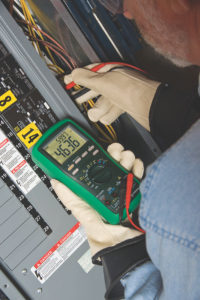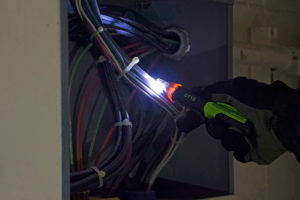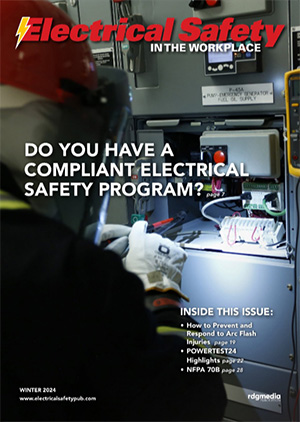Before You Get Started: Things to Consider in Low-Voltage Work
By Tim Kopp, Contributor
 The importance of safety and taking safety precautions cannot be overstated when working on or near energized equipment. In low-voltage environments having the proper personal protective equipment (PPE) like safety glasses, insulated gloves, and insulating mats is essential. Additionally, following basic recognized guidelines when using electrical test equipment goes a long way in enhancing worksite safety. These include:
The importance of safety and taking safety precautions cannot be overstated when working on or near energized equipment. In low-voltage environments having the proper personal protective equipment (PPE) like safety glasses, insulated gloves, and insulating mats is essential. Additionally, following basic recognized guidelines when using electrical test equipment goes a long way in enhancing worksite safety. These include:
- Having test equipment that has been certified by an independent testing agency, such as Underwriters Laboratories (UL) in the United States and Canadian Standards Association (CSA) in Canada. This certification ensures that the tester has been verified independently to meet the minimum safety standards set by these organizations.
- Ensuring that there are no atmospheric hazards in the measurement area such as combustible gas or other environmental risks.
- Following the old electrician’s rule that you should use only one hand when working on live circuits. It helps keeps you from establishing a path for the electricity to flow through your chest (i.e., your heart). An easy way to follow this rule is to use alligator clips on your meter test leads; this allows you to connect to only one portion of the circuit at a time.
- Making sure your test equipment is rated for the environment you are working in for measurement that you are about to take.
- Take the time to make sure that the function switch is set correctly and that your test leads are connected properly.
Another important consideration when choosing the proper test equipment is overvoltage protection. This is the one of the most important safety features a test equipment can have because it helps protects the user from electrical shocks and electrical arcing. Choosing the right tester means understanding what level of voltage protection is needed for a given environment. It’s key to remember:
- Category ratings communicate the level of overvoltage protection built into the tester and the environment in which it is designed to be used. The category rating is listed I through IV and each number represents a specific area of the electrical environment.
- The category and voltage rating will be marked on the meter, typically near the test lead (voltage) input jacks.
 To get into a little more detail, let’s look at each category rating and what it means.
To get into a little more detail, let’s look at each category rating and what it means.
- Category I is the lowest level of overvoltage protection available. A Category I test instrument is designed to work only on low-voltage signals. This would be the circuit board level of electronic equipment like fax machines, copy machines, etc. It would be difficult to find a piece of test equipment rated this low since it would severely limit its professional use. Most meters are rated at least Category II.
- Category II is the local level for fixed and non-fixed powered devices. These are receptacles of long branch circuits where you plug in appliances and portable tools. These are usually single-phase electrical outlets.
- Category III is the distribution level or panel. These circuits are usually separated from the Category IV environment by a minimum of one level of transformer isolation. Category III consists of feeders and short branch circuits (less than 30′ from the distribution panel) and heavy appliance outlets with direct or “home run” connections to the service entrance. Most professional electricians work in a category III environment daily. Therefore, a professional electrician should consider Category III as the minimum level of overvoltage protection for their meter.
- The highest level of overvoltage protection is Category IV. It is the primary supply level, also known as the service entrance, and it includes any outside overhead or underground lines that might be running between, say, a house and a detached garage. Category IV 1000 volts is the highest level of protection specified by the IEC standard.
Regardless of the test equipment selected it is always essential practice to follow the three-point test method:
- Use the meter to measure a known energized circuit.
- Take the measurement of the desired test circuit.
- Retest the first known energized circuit.
This method protects the user by determining if the meter is functioning properly, if the test leads are in proper operating condition, and whether the meter is set to the appropriate function.
Understanding the role proper test equipment, overvoltage protection, and the three-point test method, as well as precautions go a long way in enhancing the safety of every job site where electrical work will be completed. ESW
Tim Kopp is a Business Development Manager at Greenlee, a leading manufacturer of high-quality tools for electrical and utility trade professionals. Learn more at greenlee.com.
Share on Socials!
How to Choose the Right Electrical Gloves for the Task at Hand
Tools to Enhance Safety in High Voltage Areas
Five Ways to Protect Workers During Plant Turn-Around or Shutdowns
Leaders in Electrical Safety
• Aramark
• Bowtie Engineering
• Enespro
• Ericson
• I-Gard Corporation
• IRISS
• KERMEL, INC.
• Lakeland Industries
• MELTRIC Corporation
• National Safety Apparel
• National Technology Transfer
• Oberon
• Saf-T-Gard
• SEAM Group
Subscribe!
Sign up to receive our industry publications for FREE!







